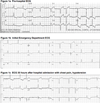Prehospital 12-lead ST-segment monitoring improves the early diagnosis of acute coronary syndrome
- PMID: 22115367
- PMCID: PMC3305819
- DOI: 10.1016/j.jelectrocard.2011.10.004
Prehospital 12-lead ST-segment monitoring improves the early diagnosis of acute coronary syndrome
Abstract
Aims/methods: We studied 620 patients who activated "911" for chest pain symptoms to determine the sensitivity and specificity of 12-lead electrocardiogram (ECG) ST-segment monitoring in the prehospital period (PH ECG) for diagnosing acute coronary syndrome (ACS) and to assess whether the addition of PH ECG signs of ischemia/injury to the initial hospital 12-lead ECG obtained in the emergency department would improve the diagnosis of ACS.
Results: The sensitivity and specificity of the PH ECG were 65.4% and 66.4%. There was a significant increase in sensitivity (79.9%) and decrease in specificity (61.2%) when considered in conjunction with the initial hospital ECG (P < .001). Those with PH ECG ischemia/injury were more than 2.5 times likely to have an ACS diagnosis than those who had no PH ECG ischemia/injury (P < .001).
Conclusions: Prehospital ECG data obtained with 12-lead ST-segment monitoring provides diagnostic information about ACS above and beyond the initial hospital ECG.
Copyright © 2012 Elsevier Inc. All rights reserved.
Figures
References
-
- Ting HH, Krumholz HM, Bradley EH, Cone DC, Curtis JP, Drew BJ, Field JM, French WJ, Gibler WB, Goff DC, et al. Implementation and integration of prehospital ECGs into systems of care for acute coronary syndrome: a scientific statement from the American Heart Association Interdisciplinary Council on Quality of Care and Outcomes Research, Emergency Cardiovascular Care Committee, Council on Cardiovascular Nursing, and Council on Clinical Cardiology. Circulation. 2008;118(10):1066–1079. - PubMed
-
- Brainard AH, Raynovich W, Tandberg D, Bedrick EJ. The prehospital 12-lead electrocardiogram's effect on time to initiation of reperfusion therapy: a systematic review and meta-analysis of existing literature. Am J of Emerg Med. 2005;23(3):351–356. - PubMed
-
- Drew BJ, Adams MG, Pelter MM, Wung SF, Caldwell MA. Comparison of standard and derived 12-lead electrocardiograms for diagnosis of coronary angioplasty-induced myocardial ischemia. Am J Cardiol. 1997;79(5):639–644. - PubMed
-
- Fesmire FM, Percy RF, Bardoner JB, Wharton DR, Calhoun FB. Usefulness of automated serial 12-lead ECG monitoring during the initial emergency department evaluation of patients with chest pain. Ann Emerg Med. 1998;31(1):3–11. - PubMed
-
- Kudenchuk PJ, Maynard C, Cobb LA, Wirkus M, Martin JS, Kennedy JW, Weaver WD. Utility of the prehospital electrocardiogram in diagnosing acute coronary syndromes: the Myocardial Infarction Triage and Intervention (MITI) Project. Journal of the American College of Cardiology. 1998;32(1):17–27. - PubMed
Publication types
MeSH terms
Grants and funding
LinkOut - more resources
Full Text Sources
Medical


